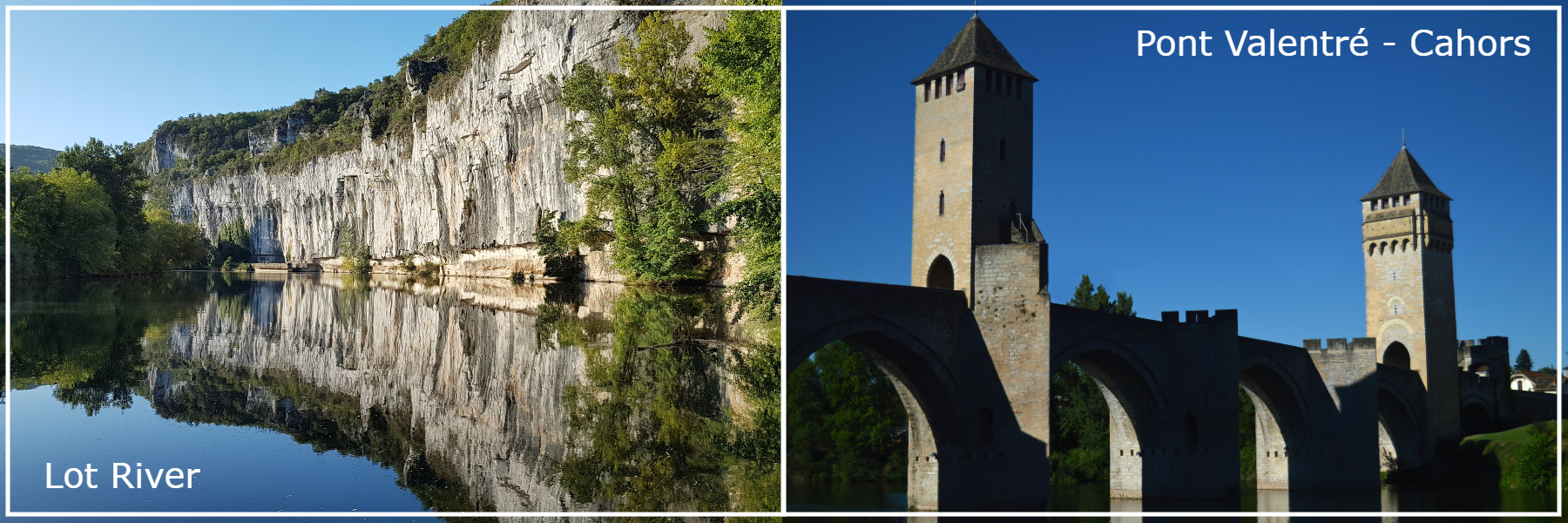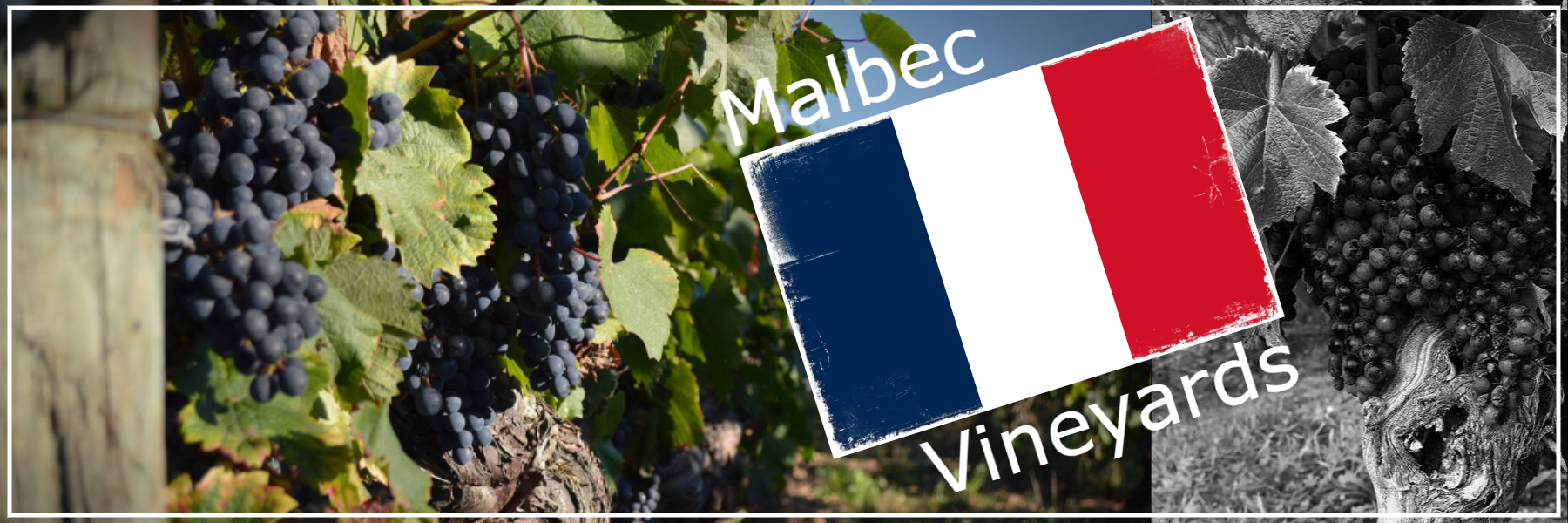An ode to Malbec - celebrating the greatness of a "macho" grape variety which delivers luxurious, concentrated wines, adored by millions the world over!
No, don’t worry, I’m not going to burst into classical poetry about this particular grape, although I’m sure someone out there on the internet has done such a thing… you find it, if you really want to.
The first “fact” given by most people, when asked about Malbec, is that it comes from Argentina. Sorry to disappoint you, but it actually originates in south-west France from a fairly obscure region called Cahors. The area is cut through (literally) by the serpentine meanderings of the Lot River which, eventually feeds into the Garonne, east of Bordeaux. Over time, the river has carved out three levels of terraces comprised of clay/alluvial gravels over a limestone base, with the highest, known as the “causse”, being 100% limestone. Dramatic cliffs line the banks of the river and the vineyards are located above these on the naturally formed terraces.
First planted by the Romans, the wines of Cahors have ridden a rollercoaster of popularity over the centuries with highs of devotees such as English royalty, Popes and Russian Tsars drinking them in preference to any other wine.
Historically, during the Middle Ages, the wines of Cahors had a better reputation than those of nearby Bordeaux and the Malbec grape, which used to be planted heavily in both regions, gave high quality in Cahors due to its drier, more continental climate. The maritime climate further to the west often produced crops beset with rot and mildew due to the wetter conditions.
Powerful and dark-coloured (Black) Malbec from Cahors was reputedly used to bolster the lighter “Clairet” wines being sold by merchants in Bordeaux at the time.

Unfortunately, in the late 19th century, viticulture in France was severely damaged by the arrival of the phylloxera aphid and most of the vineyards in Cahors were turned over to the production of other crops, or simply abandoned. Later, a massive, severe frost, in 1956, wiped out much of the remaining vines and the whole region’s wine production and reputation fell into steep decline.
Some vineyards were eventually replanted with much of the wine being made by the local cooperative. Appellation (AOP) status came eventually in 1971 with the regulations stipulating a minimum of 70% Malbec (known locally as Cot/Auxerrois) to be used, the remaining 30% comprising a combination of Merlot & Tannat, making the wines stylistically different to those made today in Argentina that tend to be 100% Malbec.
I think I've covered the basics here; a bit of history, geography, geology, climate, grapes, all adding up to what is known in France as "terroir". It is, after all, what makes Malbec from Argentina different to a Cahors wine.

As a wandering oenophile, I like to think I've been to all the important wine regions, but there are still some missing from my list. Cahors is one of those areas that remain undiscovered by me. It's not a touristy area as yet and, with the current travel restrictions, I'll have to wait a bit longer before visiting quite a long list of potential chateaux.
Many years' ago, I did once employ someone who came from Toulouse, the nearest large city to Cahors but, for any regionally acquired wine knowledge, he might as well have come from the moon. "C'est la vie!" as the locals would say. To be fair, it's 100km as the crow flies from Toulouse to Cahors, so not really a local after all. It would be like asking a Londoner where the best restaurants were in Birmingham. Why would they know? And don't say, "there aren't any", because you'll find everything from "Michelin Star" to [controversially] many #Curry houses who quite happily stock plenty of Malbec, although the Argentine wine is more likely to be seen on their list.
Thinking back, in the early ‘80s, my first experience of a Malbec wine was simply labelled “Cahors” (no producer name given) and was not at all a pleasant experience! It’s stuck in my mind as it was surprisingly light, astringent and would definitely fall into the “cheap & nasty” category of French plonk. Not a good start for a grape with so much potential and certainly no match for anything now coming from South America. But there were no South American wines on the UK market back then, so an unfair comparison.
Moving on a couple of decades, and a massive increase in quality, I next sampled some fantastic bottles from Pascal Verhaeghe’s Chateau du Cèdre . Both the “Prestige” and “Le Cèdre” were superb wines with beautifully balanced fruit and tannins. Priced at £20 and £40 respectively. Worth every penny!
There are now quite a few producers that are aiming for the top end of the market. Quality is excellent and the pricing, generally £20+, is good. Like all things in life, you get what you pay for so, if you’re happy with wines at £100-£200 a bottle, go for it. They’re still a tenth of the price of the First Growth Bordeaux reds!
This is where we now come to Chateau Lagrezette.
A premium grower offering wines from around £15 right up to £150+ for hand-made, small production, top-of-the-range bottles.
Available at Frazier’s, now!

In need of some serious red wine the other day, I decided to try their "second label" Chevalier du Chateau Lagrezette for £23.99/bottle. What a choice. So good!
It was one of those rarely found bottles that tasted just right as soon as the cork was removed.
Mellow, smooth and chocolate-rich texture with dark fruit flavours developing in the glass, opening up to offer a savoury character on the mid-palate that I wasn’t expecting. Tannin & oak, yes, but so well judged that it was hardly noticeable in the background. Remarkable balance in such a young wine. Drink now, or keep for a few more years.
All it needed was some meat to go with it… (easily remedied) and, by the time the food was ready to eat, the wine tasted even better. A winner!
If you need a further recommendation, Tamlyn Currin of JancisRobinson.com, says:
"Vanilla-scented violets and hot-summer-ripe mulberries. A touch of tea leaf and freshly picked rosemary lifting high nostril-filling notes over the mocha and dark, grilled plums of the palate. More than a smudge of chocolate, creamy/milky rather than dark. The tannins have a certainty without being dogmatic, not quite silky, not rustic either. You want to rub into them. They remind me of bamboo fabric. Some black-olive tapenade bitterness on the finish. The perfect wine for coffe-rub beef short ribs and a minty roast-courgette salad. (TC)", 16.5/20 points
A very conservative score, I think, but the wine’s now had a further year’s ageing in bottle, gaining more complexity, since Tamlyn’s tasting.
If you’ve never come across the wines of Chateau Lagrezette, here’s some background information:
Bought, in 1980, by the CEO of luxury Richemont Group, Alain Dominique Perrin, as a personal, country abode, to escape the day to day business of the likes of Cartier, the 12th century chateau was rundown, but was clearly an ancient site needing loving restoration. It turned out to have 3.5ha of vineyard land attached to the property and the idea was born to reinstate them. It was discovered that its previous confirmed reputation went as far back as the year 1503 with vines being planted long before that.
After twelve years of hard work and a huge amount of money, the chateau was finally restored and numerous stars from the world of music and Hollywood films visited. No name dropping, but very much “A” listers! You could ask: "What's love got to do with it, when I'm still standing?"
This was certainly a property with potential for making great wines if it could be brought kicking and screaming into the 21st century.
The initial vintage from the existing vines was 1983, but the first to be sold commercially was the 1985. A long way from the fantastic standard now being achieved.
Shortly after, in 1987, viticulture and winemaking were soon to advance with consultant, Michel Rolland, brought in to introduce new techniques, starting with the construction of a gravity-fed winery, a change to later harvesting dates, yield reduction and a more refined oak regime improving quality. After more than 30 years of endeavour the wines made have improved dramatically, now competing with the best in the world.
Michel Rolland is well known for his work with Malbec in Argentina at Clos de los Siete and at various Bordeaux chateaux, particularly around the Pomerol appellation (including Le Bon Pasteur ) with the Merlot variety.
Further vineyards, totalling around 100ha, have since been purchased in both Rocamadour and the commune of Landiech (planted to Malbec) adding to the original site at Caillac, just west of the town of Cahors itself, which is planted with 83% Merlot/16% Merlot/1% Tannat.
Since 2007, winemaker Cedric Blanc has been in charge of day-to-day management at the winery.

From these estate vineyards, he makes four exciting wines:
- 1. Chateau Lagrezette - The estate’s main wine (20-30 year old vines, 94% Malbec, 6% Merlot/Tannat, with 18 months in 50% new oak)
- 2. Chevalier du Chateau Lagrezette - The “second wine” of the property (84% Malbec, 16% Merlot, with 1 year in oak, 10% new)
- 3. Cuvee du Dame Honneur du Chateau Lagrezette - A selection from several parcels behind the chateau (89% Malbec, 11% Merlot, with 2 years in new French oak)
- 4. Le Pigeonnier- A single 2.7ha parcel in front of the chateau (100% Malbec, with 2 years in new oak)
The vineyards at Landiech supply a further two wines to the Lagrezette range:
- 1. Cuvee Marguerite – single vineyard 20km west of the Chateau (100% Malbec, 16 months in 30% new oak, the rest in 2nd/3rd use wood, low 35hl/ha yield, only 5000 bottles made each year) - named after Marguerite de Massaut, a 16th century owner of the property.
- 2. Paragon – a special selection, 100% Malbec, from the Landiech vineyard (20-22 months in 100% new oak)
All six of these wines are top scoring (90-95/100 points) at the Wine Advocate.

The wines from the Landiech vineyard are considered to be more elegant in style than the main estate wines and the fruit comes from vineyards planted in 2009.
The exceptional 2015 Cuvee Marguerite won the “2018 Malbec Masters” competition with a 97/100 score, beating everything that Argentina could throw at it.
A “third wine”, Seigneur de Grezette Malbec, contains declassified estate fruit along with grapes from other sites around Cahors. Fruit forward, soft and ready to drink now… and much cheaper!
There’s even another entry-level red, just called “Purple” Malbec, and a selection of Viognier-based whites (not sold as Cahors).
That’s a lot of excellent wines from Lagrezette
Who needs Argentina with wines like this?
I’d just have the best of both!
All these facts have made me very thirsty. Which bottle to open next?

